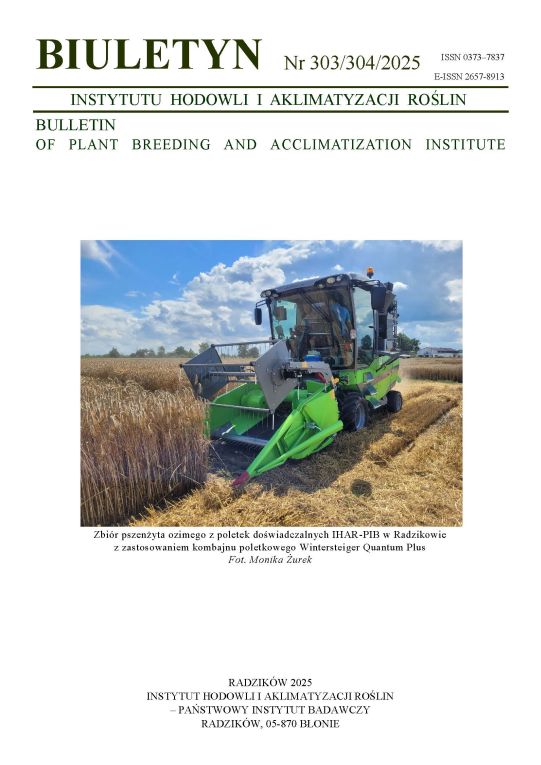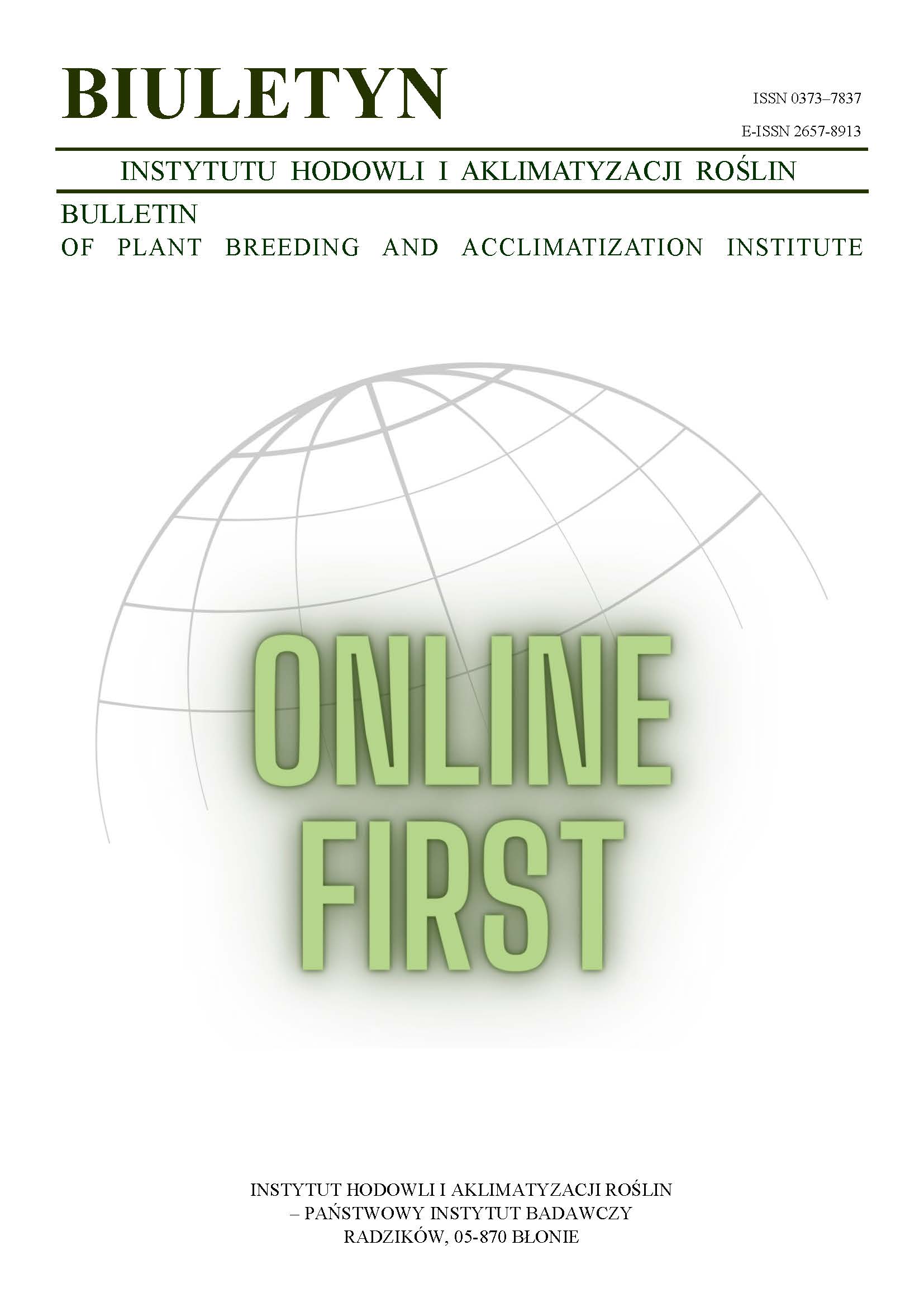Architecture of spring triticale and spring wheat stands at different population densities
Piotr Nieróbca
iung@iung.pulawy.plZakład Uprawy Roślin Zbożowych, Instytut Uprawy, Nawożenia i Gleboznawstwa w Puławach (Poland)
Abstract
Two microplot experiments with spring triticale var. Gabo and spring wheat var. Igna were conducted in Puławy in the years 1994–1996. Three plant densities (300, 450 and 600 plants/m2) were applied. At the full ripeness stage 20 successive plants from the middle part of rows in each plot were taken, and agronomic characters of stand (percentage of plants and shoots of different height, their productivity and the share in yield forming) were determined. At low sowing density spring triticale propagated much better than spring wheat. It produced shorter lateral shoots, especially of third and fourth order irrespective of a sowing rate. In spring triticale, the heads of lateral shoots were developed not as well as those of main shoots, whereas in spring wheat heading was more uniform. In both, spring triticale and spring wheat, the highest grain yield was produced by main shoot heads of well propagated plants, irrespective of population density.
Keywords:
canopy architecture, sowing density, spring wheat, spring triticaleReferences
Jaśkiewicz B. 1995. Wzrost rozwój oraz plonowanie pszenżyta ozimego w zależności od terminu siewu i obsady roślin. Puławy R (328).
Google Scholar
Koczowska J., Korona A.: 1994. Zmienność korelacyjna wybranych cech pszenżyta jarego. Zesz. Naukowe AR w Szczecinie 162: 67 — 72.
Google Scholar
Kozdój J. 1992. Wpływ wybranych czynników środowiska na morfogenezę kłosa i potencjał plonotwórczy zbóż. Biul. IHAR 183: 59 — 71.
Google Scholar
Mazurek J., Jaśkiewicz B., Sułek A. 1991. Wpływ ilości wysiewu na plonowanie, strukturę plonu oraz jakość ziarna nowych odmian i rodów pszenicy jarej. IUNG Puławy, R (288): 35 — 39.
Google Scholar
Mazurek J., Kuś J., Maj L. 1991. Wpływ ilości wysiewu na plonowanie 3 odmian pszenicy jarej. IUNG Puławy, R (288): 49 — 58.
Google Scholar
Podolska G. 1995. Struktura plonu i architektura łanu odmian pszenżyta ozimego w zależności od warunków glebowych. Puławy, R (323).
Google Scholar
Stankowski S. 1994. Reakcja pszenżyta jarego na termin siewu, ilość wysiewu, rozstawę rzędów i głębokość siewu w uprawie na glebie lekkiej. AR Szczecin, Rozprawa habilitacyjna, nr 159.
Google Scholar
Authors
Piotr Nieróbcaiung@iung.pulawy.pl
Zakład Uprawy Roślin Zbożowych, Instytut Uprawy, Nawożenia i Gleboznawstwa w Puławach Poland
Statistics
Abstract views: 68PDF downloads: 27
License
Copyright (c) 2004 Piotr Nieróbca

This work is licensed under a Creative Commons Attribution-ShareAlike 4.0 International License.
Upon submitting the article, the Authors grant the Publisher a non-exclusive and free license to use the article for an indefinite period of time throughout the world in the following fields of use:
- Production and reproduction of copies of the article using a specific technique, including printing and digital technology.
- Placing on the market, lending or renting the original or copies of the article.
- Public performance, exhibition, display, reproduction, broadcasting and re-broadcasting, as well as making the article publicly available in such a way that everyone can access it at a place and time of their choice.
- Including the article in a collective work.
- Uploading an article in electronic form to electronic platforms or otherwise introducing an article in electronic form to the Internet or other network.
- Dissemination of the article in electronic form on the Internet or other network, in collective work as well as independently.
- Making the article available in an electronic version in such a way that everyone can access it at a place and time of their choice, in particular via the Internet.
Authors by sending a request for publication:
- They consent to the publication of the article in the journal,
- They agree to give the publication a DOI (Digital Object Identifier),
- They undertake to comply with the publishing house's code of ethics in accordance with the guidelines of the Committee on Publication Ethics (COPE), (http://ihar.edu.pl/biblioteka_i_wydawnictwa.php),
- They consent to the articles being made available in electronic form under the CC BY-SA 4.0 license, in open access,
- They agree to send article metadata to commercial and non-commercial journal indexing databases.
Most read articles by the same author(s)
- Piotr Nieróbca, The response of spring triticale varieties to the sowing time and rate , Bulletin of Plant Breeding and Acclimatization Institute: No. 247 (2008): Regular issue
- Piotr Nieróbca, Jerzy Grabiński, The composition of a winter rye crop depending on soil conditions , Bulletin of Plant Breeding and Acclimatization Institute: No. 228 (2003): Regular issue
- Piotr Nieróbca, The effect of nitrogen fertilization, sowing time and sowing density on yield and yield components in the spring triticale , Bulletin of Plant Breeding and Acclimatization Institute: No. 231 (2004): Regular issue
- Piotr Nieróbca, Response of new varieties of spring triticale to the delay in sowing term at different plant densities , Bulletin of Plant Breeding and Acclimatization Institute: No. 236 (2005): Regular issue
- Piotr Nieróbca, The effect of nitrogen fertilization, sowing time and sowing density on yield and yield components of spring triticale , Bulletin of Plant Breeding and Acclimatization Institute: No. 220 (2001): Regular Issue














